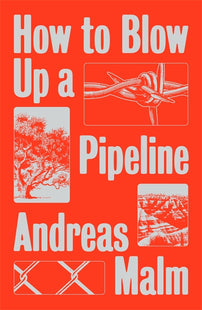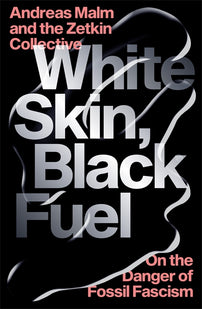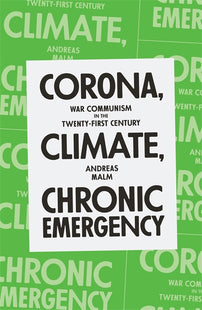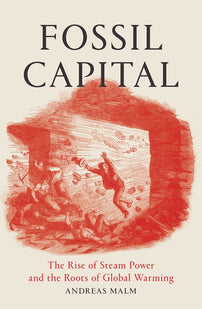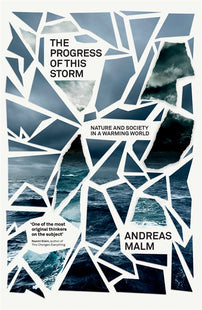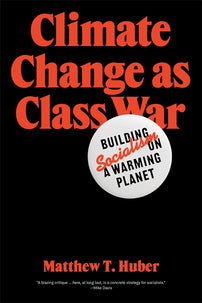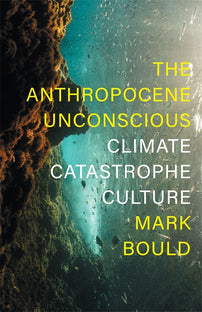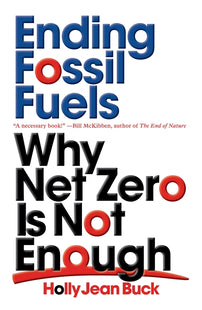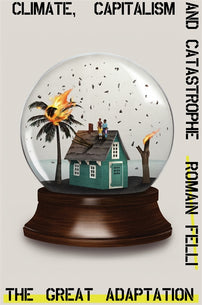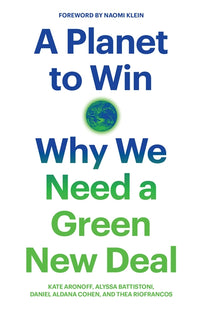COPs in the Breakdown: Notes on Glasgow and the Year 2021
Combatting climate change will take more than adapting to its symptoms. In this reflection on COP26 and a year of climate disaster, Andreas Malm argues that governments need to start targeting the causes of the climate crisis, beginning with fossil fuels.

What was the best thing that happened in Glasgow during COP26? 60 SUVs were deflated in the posh west end. Imagine if that action were to spread to other enclaves of the rich. Then we could perhaps see some real cuts into the curve of the most bizarrely outsized source of luxury emissions.
Greta Thunberg reached out to striking refuse workers in the city. They reciprocated in kind and joined the crowd of around 100,000 marching for climate action. Imagine if such solidarity were forged around the world, tributaries from schools and workplaces flowing into a rising river of strikes: for survival of the next generation, for decent lives for all. Then we could perhaps see the climate movement amassing some real striking force.
Young climate activists from the Global South – Baluchistan and Tuvalu, Brazil and Uganda, India and Ecuador – came together in the People’s Summit, talked to each other, shared experiences and pondered next moves. Imagine that sort of cadre formation proceeds apace: eloquent, enraged, politically educated fighters for climate justice, uniting across the South in the moment of deepening crisis. Then we could perhaps see a real revolutionary subject emerge out of the most affected people and areas.
But if the yardstick is generalisability, what of COP26 itself? Imagine the summit were to be extrapolated…then we’d get another quarter of a century of blah blah blah, more of the same, a continuation of what we’ve had since COP1: diplomatic logorrhea as the endless soundtrack to growing emissions. Next year, COP will be held in Egypt. The year after that, in 2023, in the United Arab Emirates. It’s as if there had been a plan to bury the coming COPs first in a graveyard for democratic aspirations and then in an oilfield, so as to ensure their definitive consignment to futility.
For many of us, that was the prime impression of COP26: an increasing irrelevance in relation to trends on the ground. One way to gauge the gap is to recall recent events on the climate front. We might begin by looking back on the summer of this year. It already feels distant, but the months between June and September 2021 provide the proper foil to the November summit in Glasgow, a measure of the fading of the COP process.
Chronicle of a season in global hell
It began with a heat dome settling over British Columbia. Some 500 people perished, as did an estimated one billion marine animals: mussels cooking in their shells, beaches covered by crusts of dead creatures, the tissues of salmon torn apart by hot river water. In California, the summer once again smashed the records for wildfires, prompting the fire chief to declare that ‘every acre can and will burn in this state’. One week into August, the biggest single blaze in Californian history had engulfed an area larger than New York City. If it was a record summer in terms of heat and fire in the west, in the state of Tennessee, on the other hand, record-breaking downpours caused flash floods that swept away houses and killed at least 22 people. In Arizona, extreme heat and drought were punctuated by a deluge that formed currents of water that carried debris from areas burnt by wildfires into the towns: what is now referred to as a ‘compound climate event’.
On the other side of the Atlantic, the floods that suddenly swept through the Rhineland in mid-July sent entire neighbourhoods of villas and parking lots of cars floating down muddy rivers; residents likened the impact to that of a bomb. Without precedent, the floods killed nearly 200 people in Germany alone, and the summer also saw bad floods in Belgium, Netherlands, Sweden, London, New York and Tokyo. And then there were the fires in the Mediterranean. The flames were on the threshold of invading Athens. Ash from the surrounding conflagrations, methodically consuming what remained of green areas around the city, rained down on its inhabitants. Temperatures hit 47 degrees. Skies were a deep orange. Greece was in a state of panic. Similar scenes played out across the Mediterranean basin, from Portugal to Cyprus, while up in Russia, the total area burned – forests, grass, reed, tundra – reached an estimated 30 million hectares, an area the size of Poland.
[book-strip index="1" style="display"]A detail from Siberia: some of the films which emerged this summer came from the Road of Bones in the Kolyma province: drivers can be seen pushing through flames that eat the fir trees on both sides of the road, the black earth and sky rent by a billowing ribbon of red. The Road of Bones is so called because several hundreds of thousands of Gulag slave labourers died during its construction, and since it was built over permafrost, the Stalinist authorities decided to inter the corpses into the very fabric of the road itself, rather than wasting resources on the nearly impossible task of digging holes. Anyone who has read Kolyma Stories by Varlam Shalamov, the greatest writer from and witness to the Gulag era (far surpassing Solzhenitsyn but far less known, perhaps because he was a Trotskyist), will associate the Kolyma province with temperatures reaching minus 40 degrees centigrade. This summer, Kolyma and the Road of Bones were on fire, and for the first time ever, smoke from the fires in Siberia reached all the way to the North Pole. In late August, temperatures at the highest peak of Greenland, more than 3,000 meters above sea level, were 18 degrees higher than the average: and for the first time in known history, rain fell on this peak.
So much for the Global North. As for the Global South, we could start by crossing the Mediterranean into Algeria, where the tinder-dry hills in the Berber region east of Algiers ignited in fires that killed some 69 people – compared to zero in California, while receiving, naturally, a fraction of the media attention. There were wildfires in the hills around al-Quds/Jerusalem, turning the terraces of trees into strips covered by a thin layer of white, eerily snow-like ash. Lebanon burnt as well, and even worse was the situation in Turkey, where swathes of the southern coast were ravaged, the heat intensity of the fires four times higher than anything on record.
Parts of the world not on fire seemed to stand under water. Disastrous flooding hit the Chinese province of Henan when a year’s worth of rain fell in little more than 24 hours, filling subways with waterfalls, opening sinkholes in roads, displacing more than 200,000 people; Chinese media said it was rain ‘unseen in the last 1,000 years’. Next in turn for flooding was the Hubei province, and before that Manila and Mumbai had been pummelled, and Bangladeshi refugee camps housing Rohingya refugees snapped like straws, because their houses were in fact built by straws, bamboo and tarpaulin, helpless against torrents of chest-high water.
Over in Afghanistan, the Taliban takeover coincided with the worst drought in living memory. In Madagascar, drought pushed more than one million to the brink of famine; in northern Kenya, more than two million, the emergency here compounded by locust invasions and flash floods, the crops of maize, the country’s staple food, projected to decline by between 50 and 100 per cent this year. The landlocked nation of Paraguay relies completely on the river Paraná. By September, the two-year-long drought had reduced water levels to the lowest seen in 77 years, the main source of water for the country – crucial for Argentina too – down to a trickle in the mud. And in the Andes, historically low snowfall left mountains brown and bare and the communities depending on their snow packs for water in despair.
Did COP26 stand in any relation to these events? Was there any meaningful connection between the talk and the text that emerged from the summit venue on the north side of the Clyde and the things that had just transpired around the world? The listed events provide, it should be noted, a mere selection from the season in global hell that was the summer of 2021. We shall look closer at another incident shortly. But first we may spot some emerging trends that further bring out the chasm between the inside of these venues and the real world outside.
Parameters of irrelevance
The general sentiment in the research community this summer appeared to be – not for the first time, admittedly – shock at the speed of events. In news reports, though obviously not yet in peer-reviewed papers, leading scientists reacted with astonishment. After the flooding in Germany, Dieter Gerten, a climatologist at the Potsdam Institute, said:
‘I am surprised by how far it is above the previous record. We seem to be not just above normal but in domains we didn’t expect in terms of spatial extent and speed’, and, he continued: ‘We need to better model nonlinear events.’
One climatologist in the state of Washington confessed that he hadn’t expected those temperatures to materialise before the second half of this century. Johan Rockström admitted to a general underestimation of the heatwaves, and Michael Mann acknowledged that climate models had failed to capture the severity and extremity of the impacts now unfolding.
If anything, climate science has erred on the side of caution and gradualism – a venerable bias of natural science under the influence of bourgeois ideology (read: Stephen Jay Gould). What still remains to be fully understood and accounted for, as of 2021, are the non-linear, sudden, catastrophic mechanisms of climate breakdown, and these include, of course, the feedback mechanisms now activated by notable forest fires. In July, fires worldwide released 1.2 gigatons of CO2 into the atmosphere, a monthly record immediately toppled in August, when the figure reached 1.3 gigatons. To the same degree that the breakdown unfolds faster than expected, it accelerates itself.
If apprehension was the sentiment in much of the research community, there was a lingering popular misconception of the arrival of a warmer world. ‘Aha’, many seemed to think, ‘this is what a changed climate looks like’ – it will be 47 degrees in Athens and one billion animals dead and a wall of water occasionally crashing through someone’s home, like in this summer. But what many then seem to forget, or not want to fully absorb, is that global warming is a cumulative process. Everything that happened in the summer of 2021 was the result of all the greenhouse gases – CO2 primarily – that have accumulated in the atmosphere over the past two centuries. (And the causation is indisputable: contrary to the long-standing myth that individual weather events cannot be blamed on global heating, for quite a few years now climate science has developed robust methods for such attribution. This summer, scientists were quick in presenting their findings: the German floods were made up to nine times more likely by anthropogenic climate change, the heat dome in British Columbia 150 times, the wildfires in Siberia 600 times, and so on. What this means is that in the absence of fossil fuel combustion, these events would have been exceedingly improbable, all but physically impossible: and that’s as firm as a chain of causation gets.)
Every impact is the outcome of the aggregate sum of emissions. More emissions, then, mean more impacts; or, for every year additional CO2 is put into the atmosphere, for every year emissions continue – they do not have to increase, just continue in some quantity, on top of what is already there – the effects will worsen. There is no baseline in global heating. There is no stability, no average, no new normal; for as long as more CO2 piles up in the atmosphere, it will get worse. Ten years down the road of emissions higher than zero and the summer of 2021 might look like a mild breeze in retrospect. And ten years down the road of stable or increasing emissions?
It is the latter scenario fossil capital is busy realising: perpetual growth of CO2 emissions in the years ahead. One week before COP26 opened its doors, the annual ‘production gap’ report was released, mapping the discrepancy between the decline in fossil fuel production required to limit global heating to 1.5°C or 2°C degrees on the one hand and the actual developments on the other. Between now and 2040, the amount of fossil fuels taken out of the ground should bend down sharply towards zero. In reality, producers are planning to keep the curves running up, up, for as long as there are reserves to extract. While COP26 was nearing its end, another report offered another angle on business-as-usual in real time: between November 2021 and the end of 2022, more than 800 new oil and gas fields will be drilled around the world. That’s 800 fields in addition to those already in operation (or exhausted) – 800 in one year alone. But these are only some signs and measurements of the undiminished ascendancy of business-as-usual; countless others could be enumerated.
What measures adopted at COP26 will make a dent in these curves? None. No decision, no initiative, no carefully phrased wording in the final ‘Glasgow Climate Pact’ will do anything to break the growth in fossil fuel production in the short term – which is the only term that counts. Promises about going net zero in 2050 or 2070 are worse than useless when they paper over growth spurts (as in the case of India). The pledges made in Glasgow would result in annual CO2 emissions at a level 14 per cent higher in 2030 than in 2010. That is, if the various voluntary pledges to nudge some activities in actually existing capitalism a little bit away from fossil fuels were to be somehow enforced rather than broken – a not so minor miracle.
And if the pledges are broken, as they habitually are? The sky, as it were, is the sole limit. From whatever angle one inspects the mathematics of COP26, this must the conclusion: nothing has brought government policies any closer to addressing climate catastrophe – to the contrary, if its cumulatively accelerating nature is considered, the chasm has merely widened. And so when these governments encounter disasters on the home front, they must do something else.
The rise of muscular adaptationism
During the summer of 2021, we saw the rise of something we might call muscular adaptationism. ‘Germany is a strong country. We will stand up to this force of nature, in the short term, but also in the medium and long term’, said Angela Merkel when visiting the flooded regions: Germany is a strong country, and we will stand up to this force of nature. We will do it even in the long term. The national guard sent boats and diving teams to search for survivors.
When towns in central Sweden were submerged in water in early August, its most macho nationalist minister, Mikael Damberg, proclaimed that ‘as the climate changes, society must mobilise power, plan and adapt our infrastructure to pre-empt and manage events of this kind’. In mid-September, eight European countries on the Mediterranean signed what’s called ‘the Athens declaration’ on better adapting to the hazard of wildfires, by beefing up disaster responses and protecting coastal zones and urban areas. Among the signatories was Emmanuel Macron, who, needless to say, did not mention Total, the single largest private corporation headquartered in France and one of the worst climate crime syndicates in the world, currently expanding its assets of destruction from East Africa via Iraq to the Arctic. Nor did the Italian government pay any attention to ENI. One of the seven supermajor oil companies in the world, ENI is responsible for the biggest share of the 800 fields to be drilled in the coming year – 49 belonging to the Italian company, compared to 40 belonging to Shell, 37 to Total, 34 to BP, and so on – but when Italy reeled under extreme heat and fires alternating with extreme precipitation and floods, this entity did not figure in the ideological reflexes of the state. Instead the army was dispatched to fight fires.
Officials from the navy promised to better protect homes from floods the next time. It was the same story in Greece: not a word about the pipelines and superyachts in the Adriatic or the lignite coal mines on the mainland. But the army was sent to tackle the blaze on Evia, while that all-too-symbolic ferry evacuated people from glowing hillsides.
This is the logic of muscular adaptationism: since the causes are never treated, the multiplying symptoms must be stamped down with greater force, accompanied by an escalating rhetoric of military and national power that can uphold a semblance of safe normality. The very states that maintain business-as-usual must send in the troops. If muscular adaptationism came to the fore in the hellish run-up to COP26, it re-emerged again just after it, in British Columbia, where the heat and fires of the summer had given way to flooding in the fall. The Canadian Forces deployed soldiers to clear roads – ‘a huge moral boost’, one mayor in a submerged town welcomed them. Moreover, state authorities imposed rationing of petrol.
Rationing of petrol? The Canadian state would never countenance such an eminently sensible measure for mitigating climate change – the province of British Columbia, of course, is crisscrossed by pipelines old, new and planned: a centre for self-destruction perhaps comparable only to the likewise settler-colonial fossil state of Australia – but when adapting to the consequences, under the rubric of a military emergency, then why not. And the state would never display soldiers to clear out the headquarters of Enbridge. And so here we are.
A self-perpetuating absurdity, muscular adaptationism harbours the illusion that these events can be managed if only the nation gets its act together and reinforces its disaster response in a proper patriotic fashion. The fantasy, of course, is that it will indeed be possible to adapt to a world careening towards 2 and 3 and even more degrees of warming. But however illusory it is, the signs from 2021 are that we will see more of this ideological practice, precisely because the dominant classes are incapable of responding in any fundamentally different way: COP26 means more boots on the ground. In Europe, not the least, this fits perfectly with policies on migration. Send out the navy to push back the boats and beef up the border with Belarus. Combine these two trends of militarisation and we can see fossil fascism plainly prefigured in the present.
As for the Global South, adaptationism with a veneer of martial success is rarely an option. One of the most significant non-outcomes of COP26 was the refusal of advanced capitalist countries to assume responsibility for climate disasters in the South and transfer financial resources to those affected: there will be no paying for loss and damage. It’s let them drown, on the Mediterranean as on the rising seas. This, of course, is the flipside of muscular adaptationism on the home front, one more way in which COP26 related to reality by letting the worst instincts and mechanisms prevail.
[book-strip index="2" style="display"]A paradox of revolting against symptoms
Unfortunately, the focus on symptoms rather than causes can be found elsewhere too. In Germany, even the Greens refused to seize the floods of this summer as an opportunity to say: wake up folks, if we don’t rid ourselves of fossil fuels, we’re going to have more and more of these disasters until we can’t live any longer. When their candidate for chancellor (now foreign minister) Annalena Baerbock visited the areas, she also concentrated on the emergency response and warned against the folly of building houses close to rivers. In a perfectly rational world, knowledge of the future hazards of dangerous anthropogenic interference in the climate system would induce rapid emissions reductions.
In a less perfectly rational world, the actual experience of such hazards should compel states to scramble for the fastest way out of the fossil economy. But in the real world that we have, the main reaction to the explosion of climate disasters seems to be: how do we get ourselves out of harm’s way from this fire or this flood or this hurricane? Not even the climate movement has managed to break through this paralysis. No crowds marched against the headquarters of ENI when fires tore through Calabria. No lignite mines were occupied in Greece. No pipelines were blown up in British Columbia (as of yet). And again, unfortunately, the same lack of response can be found in the global south. To study this absence, we might look at one case in closer detail.
Of the climate disasters of the past summer, only one (to the knowledge of this author) triggered a political uprising. It happened in Iran, in the south-western province of Khuzestan. In July, large crowds thronged streets and shouted ‘I am thirsty!’; because the mercury hit 50 degrees in daytime, the demonstrations had to happen late at night. Inevitably, the crowds also started chanting slogans against the Islamic Republic and its supreme leader Ayatollah Ali Khamenei, and the Islamic Republic responded with the standard fare of repression: shutting down internet in Khuzestan, sending in police and basij to kill around a dozen people. These were widely reported as ‘water protests’, and their background was straightforward enough: the summer of 2021 was the driest Iran had experienced in at least half a century with precipitation having fallen to 15 percent of the average in the southwest. As temperatures hovered around 50 degrees, the rivers nourishing Khuzestan dried out downstream, leaving fields baked, water buffaloes dying and potable water in even shorter supply than usual. On top of this came another season of dust storms. Popular patience snapped, leading to what might have been Iran’s most intense – if short-lived – climate-induced revolt so far.
Now, Khuzestan incidentally occupies a special place in the annals of fossil capital. It was here, in the village of Masjed-e Soleyman, that British explorers first struck oil in the Middle East in 1908. The find inaugurated the era of Middle Eastern oil, pivot for petroleum-fuelled capitalist development in the twentieth century. After the revolution of 1979, all oil and gas reserves and installations were nationalised, and they have since remained under the tutelage of the National Iranian Oil Company, or NIOC, the pillar of the national bourgeoisie of Iran, sometimes referred to as ‘the millionaire mullahs’. And the foundation of this pillar is Khuzestan, which holds 80 percent of the oil and 60 percent of the gas reserves controlled by the NIOC. The fossil fuels of Khuzestan, therefore, have made a non-trivial contribution to global heating. By 2017, the NIOC – that is, for all practical purposes, the enterprise exploiting Khuzestan – was the fifth largest corporation in the world when measured in the greenhouse gas emissions its products generated.
And now Khuzestan is itself feeling the heat. Over the past two decades, the heatwaves have become more frequent, severe and long-lasting; in 2017, the provincial capital of Ahvaz hit 54 degrees Celsius, still the all-time record for temperatures in Asia. Evaporation rates have reached extreme levels and increased irrigation demands. Rain-fed fields have had to be abandoned; and in 2018, authorities went so far as to ban rice cultivation. Drought is more than the new normal: one Iranian climatologist has proposed ditching the term for ‘drying up’ – a permanent ongoing desiccation of the province – and then there are the dust storms. They began in 2001 and have since become steadily harsher, winds sweeping up dust from the drying plains and blanketing towns in a greyish-yellowish film that blots out the sun, brings life to a standstill and sends thousands to hospitals because they can’t breathe.
During the past three decades, more than 1,000 rural settlements have been evacuated, primarily because of such climatic stress. Some of the main cities – among them Masjed-e Soleyman – are undergoing depopulation, likewise primarily because of the heatwaves and the dust storms. In the words of one team of Iranian researchers, global heating has already ‘compromised the human habitability of the region’, and all of these trends are in line with climate projections for Iran as a whole: it will get even drier and hotter in the decades ahead.
Now, to understand this summer’s uprising, some political dimensions of fossil-fuelled capitalist development in Iran must be taken into account. Khuzestan is home to the country’s largest Arab population, somewhere between 2 and 5 million people, probably still a majority. But the millionaire mullahs ruling from Tehran are overwhelmingly Persian. The principal material base of that class is the abundance of fossil fuels, withdrawn from Khuzestan to feed metropolitan accumulation, giving rise to an ethno-political contradiction similar to that of other oil-producing nations: the centre cannot trust the minority to govern the most precious of resources – strict military control must be upheld. The Arabs have long been suspected of insufficient loyalty to the nation, in league with Saddam Hussein or Saudi Arabia. And conversely, the Arabs have long resented the seizure of the riches under their feet.
Unsurprisingly, then, people in Khuzestan harbour grudges against the Islamic Republic for subjecting them to bad weather. The water protests were triggered by a viral film clip in which an Arab sheikh in traditional dress accused officials of orchestrating it: ‘Look, we are not going to leave this land, you brought us floods and drought to make us migrate. We won’t leave, this is our ancestral land’. A popular theory says that the Persian centre has deliberately engineered the destructive weather to consummate the dispossession of the Arabs and take over the province in full. This isn’t quite right. What the Iranian dominant class is doing deliberately is something rather different: it is maximising the recovery of fossil fuels, thereby contributing to writing out a death sentence for Khuzestan and much of the rest of Iran too. In November 2019, then-president Hassan Rouhani announced the discovery of a new giant oilfield in Khuzestan, adding one third to the nation’s reserves in one stroke – ‘a small gift by the government to the people of Iran’, he called it.
In January this year, the largest gas refinery in the Middle East went online, slated to produce 56 million cubic metres of processed gas per day and some 700 million dollars of profit per year, in the eastern corner of Khuzestan. And this is unlikely to have been the last act of business-as-usual in the province.
So far, however, all the bitterness voiced against the Islamic Republic has stayed at the level of symptoms – people are upset about being left to their fate in a land where there is no longer water. But what they have not yet done is target the platforms and the refineries, or even chant against their expansion. This cannot be explained by the Arabs of Khuzestan gaining from the oil and gas: they have gained about as much as the Ogoni people in the Niger Delta.
There is a genuine paradox at work here. All the data suggests not only that the Global South bears the brunt of climate suffering, but also that people tend to be more aware of and expressing greater concern about the climate crisis here than in the North. And yet if one looks at the field of political protest, the pattern is the inverse. In a remarkable paper published last year in Environmental Research Letters, the brilliant community of political ecology scholars in Barcelona mapped 649 cases of what they call ‘place-based resistance’ against energy projects, as in a village marching against a planned coal-fired power plant or indigenous people camping out to stop a pipeline or Ende Gelände. One of their findings was that such resistance has led to the cancellation of projects in about a fifth of the cases. That’s a far higher rate of climate mitigation than any COP summit can boast. Another finding is that resistance in the North is often articulated as a climate struggle, strictly and explicitly, while in the South – where the struggles are oftentimes more common, intense and violent – that theme is largely absent. Instead, indigenous people protest the contamination of their water resources, or peasants are outraged at air pollution or loss of sacred land or unsatisfactory compensation. The climate dimension is not prominent in the rhetoric here. How can this be? It would not be a paradox if the data indicated that climate change is primarily a concern for the privileged in the North – a false impression still in circulation – but it’s exactly the other way around.
To return to the case of Khuzestan: levels of concern about climate change are likely to be extremely high and knowledge of its causation fairly widespread, and still we have yet to see any water protests that go after the source as such, even though that source is to be found literally a stone’s throw away.
Perhaps a sketch for an explanation would be something like this: when climate disaster strikes in the Global South, it activates layer upon layer of injustices sedimented over a long time, and popular rage is then more likely to target the known perpetrators of these pre-climatic injustices, in relation to the acute symptoms of disaster. In more concrete terms: the Arabs of Khuzestan have built up discontent with their overlords in Tehran for at least three decades, and when their lives are crushed by global heating, the natural outlet for their desperation is those well-known enemies – not (yet) because they profit from fossil fuels, but because they have for so long been kicking around the Arabs and taking away their lands. Furthermore, all kinds of misery – not only those related to climate – are, of course, worse in the South than in the North, which means that any climate-induced event gets tangled up in every manner of other conflict. And so, paradoxically, a revolt like this could also end up deflecting from the ultimate sources.
The wager here must be that this paradox comes to an end at some point. The revolts themselves will certainly continue to erupt; indeed, Iran just saw fresh water protests suppressed by the same violent means, this time in Esfahan. But the turn from symptom to cause will not necessarily happen spontaneously. It would rather seem to require the intervention of a vanguard of climate justice activists in the Global South – something that is not yet on the horizon in Iran, but certainly in a few other places. The generation represented by Vanessa Nakate has a historical mission to accomplish. If COP26 was an occasion – which COP27 and COP28 are very unlikely to be – for the movement to solidify, then at least something good will have come out of it. But there is some way to go before the Children of Kali scenario materialises.
How to uproot the system
What of the movement in the Global North? Fridays for Future staged their comeback on 24 September, right between the summer in hell and COP26. After the pandemic-induced hiatus, the rhetoric had radicalised considerably. The slogan for this Friday of school strikes was ‘uproot the system’, and the manifesto had adopted some unmistakable left – not anti-capitalist as much as intersectional – idiom:
The climate crisis does not exist in a vacuum. Other socio-economic crises such as racism, sexism, ableism, class inequality, and more amplify the climate crisis and vice versa. It is not just a single issue, our different struggles and liberations are connected and tied to each other. We are united in our fight for climate justice (…). MAPA [most affected peoples and areas] are experiencing the worst impacts of the climate crisis and are unable to adapt to it. This is because of the elite of the Global North who have caused the destruction of the lands of MAPA through colonialism, imperialism, systemic injustices, and their wanton greed which ultimately caused the warming of the planet.
By the same token, however, the antinomies of the movement also became apparent. On the evening of 24 September, after addressing the crowd in Berlin, Greta Thunberg tweeted: ‘We’re back! Today we were over 100 000 on the strike in Berlin and 620 000 in Germany alone along with many in other parts of the world, asking world leaders to #UprootTheSystem’. But you cannot ask world leaders to do such a thing, any more than you could base anti-fascist politics in Italy in the 1920s on asking Mussolini to commit suicide.
This is not to poke fun at comrade Greta – to the contrary, we should bow in respect for her, as she has snubbed all efforts at co-opting her and her movement into the cant of the dominant classes. No activist has had more opportunities to sell out than Greta, and none has so consistently answered by (figuratively speaking) spitting in world leaders’ faces. As she talks less about ‘listen to the science’ and more about colonialism and workers, no wonder mainstream figures like Michael Mann or the leader of the youth federation of the social democratic party in Greta’s Sweden are now complaining about her unhelpfulness (the former defending COP26 from her trash talk). She’s not so cute any longer. She has proven herself an exemplary leader (one might even be tempted to say that there is something aptly Hegelian about the spirit of climate action being embodied in this slender, resolutely extra-institutional figure). She is moving, if only gropingly – and who can blame her: there is not an excess of credible revolutionary projects these days – towards some sort of programme and strategy for uprooting the system. Marching on certain Fridays is obviously not going to do it alone. What it will take is not yet clear. More action along the lines of deflating SUVs and striking together with workers would be possibly a good start. As for the COPs themselves, no one can believe any longer that they will save us. They might be more part of the problem than of the solution.
[1] This text incorporates sections from the keynote address at the Sixth Annual Conference of the Danish Study for Marxist Studies: Capital, Climate, Crisis, Aalborg University, 2 October 2021.

